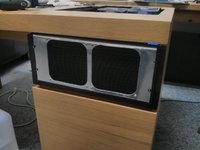Mungler
n00b
- Joined
- Oct 13, 2005
- Messages
- 34
My faithful akasa server case has served me well for a long time, but now the time has come to move on. My wife hates the size of the case and has seen how little of the space inside is utilised so tasked me with downsizing. I took the opportunity to suggest 'getting rid of the case entirely' whilst rubbing my hands together with glee. This carefully worded statement led me to embark upon placing the computer in my desk. She did catch on after a while but, after agreeing to add some blue LED's, the project gained full approval 
So here is how it looks at the moment, complete with a chair stolen from the dining room.
The front panel of the draw will have a dual rad mounted in it with fans drawing air into the space and a second dual rad will be placed into the top surface of the desk to serve as an exhaust (arrows in the picture indicating airflow), with the components and water loop items in the space in between. The I/O panel will emerge out to the underside of the desk where a cable channel already exists. The GPU is mounted flat, via a pci-e extension, to impede airflow as little as possible. The ports emerging as the I/O panel does.
The eagle eyed amongst you may have spotted my first challenge, that PSU.
Standing on its narrow side would allow the motherboard to be pushed back further making the cabling area safer, but will leave very little clearance for the rad.
I started a separate discussion about options for the PSU, including taking it apart. I'm still sitting on the fence regarding what to do here (I have invested in a bunch of temperature probes in order to investigate further.
In the mean time I move on to a physical mock up
Using a spare ATX PSU I was able to get a much better perspective on the problem. There is about 1cm of clearance between the PSU and the 'radiator'
With the PSU laid down I have a good clenched fist or 7.5cm of clearance for the rad but have to sacrifice space near the front and the I/O panel (and GPU ports) slide further into the realms of knee damage. For now, this is what I think I should go with. It will be simple enough to add a knee guard under the desk to prevent accidental port damage. Also I can flip the PSU fan so that it is pushing air up to the exhaust rad. I may decide to ventilate the leading edge of the PSU and block off the regular vent in order to keep everything in line airflow wise, but this is still being tested at the moment.
Next step will be design finalisation and kit purchase.
So here is how it looks at the moment, complete with a chair stolen from the dining room.
My cunning plan is to put the components into the top drawer, complete with window and a nice custom water loop to replace the AIO cooler currently being used.old picture links are dead. http://mungler.co.uk/pc-build
old picture links are dead. http://mungler.co.uk/pc-build
The front panel of the draw will have a dual rad mounted in it with fans drawing air into the space and a second dual rad will be placed into the top surface of the desk to serve as an exhaust (arrows in the picture indicating airflow), with the components and water loop items in the space in between. The I/O panel will emerge out to the underside of the desk where a cable channel already exists. The GPU is mounted flat, via a pci-e extension, to impede airflow as little as possible. The ports emerging as the I/O panel does.
The eagle eyed amongst you may have spotted my first challenge, that PSU.
Standing on its narrow side would allow the motherboard to be pushed back further making the cabling area safer, but will leave very little clearance for the rad.
I started a separate discussion about options for the PSU, including taking it apart. I'm still sitting on the fence regarding what to do here (I have invested in a bunch of temperature probes in order to investigate further.
In the mean time I move on to a physical mock up
old picture links are dead. http://mungler.co.uk/pc-build
Using a spare ATX PSU I was able to get a much better perspective on the problem. There is about 1cm of clearance between the PSU and the 'radiator'
old picture links are dead. http://mungler.co.uk/pc-build
With the PSU laid down I have a good clenched fist or 7.5cm of clearance for the rad but have to sacrifice space near the front and the I/O panel (and GPU ports) slide further into the realms of knee damage. For now, this is what I think I should go with. It will be simple enough to add a knee guard under the desk to prevent accidental port damage. Also I can flip the PSU fan so that it is pushing air up to the exhaust rad. I may decide to ventilate the leading edge of the PSU and block off the regular vent in order to keep everything in line airflow wise, but this is still being tested at the moment.
Next step will be design finalisation and kit purchase.
Last edited:
![[H]ard|Forum](/styles/hardforum/xenforo/logo_dark.png)

